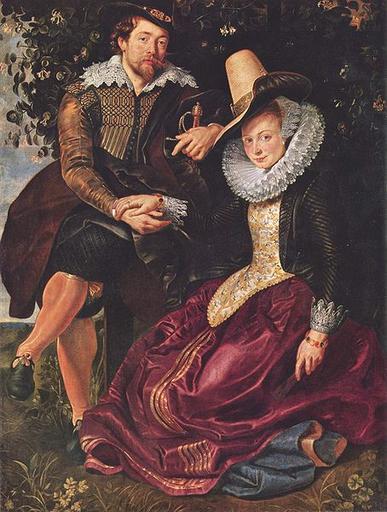MAKE A MEME
View Large Image

| View Original: | Peter_Paul_Reubens,_a_self-portrait_with_his_wife,_Isabella_Brant.jpg (454x600) | |||
| Download: | Original | Medium | Small | Thumb |
| Courtesy of: | www.flickr.com | More Like This | ||
| Keywords: Sir Peter Paul Rubens (June 28, 1577 – May 30, 1640) was a prolific seventeenth-century Flemish Baroque painter, and a proponent of an exuberant Baroque style that emphasized movement, color, and sensuality. He is well-known for his Counter-Reformation altarpieces, portraits, landscapes, and history paintings of mythological and allegorical subjects. In addition to running a large studio in Antwerp which produced paintings popular with nobility and art collectors throughout Europe, Rubens was a classically-educated humanist scholar, art collector, and diplomat who was knighted by both Philip IV, king of Spain, and Charles I, king of England. Rubens was born in Siegen, Westphalia, to Jan Rubens and Maria Pypelincks. His father, a Calvinist, and mother fled Antwerp for Cologne in 1568, after increased religious turmoil and persecution of Protestants during the rule of the Spanish Netherlands by the Duke of Alba. Jan Rubens became the legal advisor (and lover) to Anna of Saxony, the second wife of William I of Orange, and settled at her court in Siegen in 1570. Following Jan Rubens' imprisonment for the affair, Peter Paul Rubens was born in 1577. The family returned to Cologne the next year. In 1589, two years after his father's death, Rubens moved with his mother to Antwerp, where he was raised Catholic. Religion figured prominently in much of his work and Rubens later became one of the leading voices of the Catholic Counter-Reformation style of painting.[1] In Antwerp, Rubens received a humanist education, studying Latin and classical literature. By fourteen he began his artistic apprenticeship with Tobias Verhaeght. Subsequently, he studied under two of the city's leading painters of the time, the late mannerists Adam van Noort and Otto van Veen.[2] Much of his earliest training involved copying earlier artists' works, such as woodcuts by Hans Holbein the Younger and Marcantonio Raimondi's engravings after Raphael. Rubens completed his education in 1598, at which time he entered the Guild of St. Luke as an independent master. Isabella Bran(d)t (1591–1626) was the first wife of Peter Paul Rubens. She was the daughter of Jan Brant, an important city official in Antwerp, and Clara de Moy. Brant married Rubens on 3 October 1609 in Saint Michael's Abbey, Antwerp. They had three children: Clara, Nikolaas and Albert. She was 34 years old when she died of the plague. In 1977, Brant appeared on a postage stamp of Anguilla. Sir Peter Paul Rubens (June 28, 1577 – May 30, 1640) was a prolific seventeenth-century Flemish Baroque painter, and a proponent of an exuberant Baroque style that emphasized movement, color, and sensuality. He is well-known for his Counter-Reformation altarpieces, portraits, landscapes, and history paintings of mythological and allegorical subjects. In addition to running a large studio in Antwerp which produced paintings popular with nobility and art collectors throughout Europe, Rubens was a classically-educated humanist scholar, art collector, and diplomat who was knighted by both Philip IV, king of Spain, and Charles I, king of England. Rubens was born in Siegen, Westphalia, to Jan Rubens and Maria Pypelincks. His father, a Calvinist, and mother fled Antwerp for Cologne in 1568, after increased religious turmoil and persecution of Protestants during the rule of the Spanish Netherlands by the Duke of Alba. Jan Rubens became the legal advisor (and lover) to Anna of Saxony, the second wife of William I of Orange, and settled at her court in Siegen in 1570. Following Jan Rubens' imprisonment for the affair, Peter Paul Rubens was born in 1577. The family returned to Cologne the next year. In 1589, two years after his father's death, Rubens moved with his mother to Antwerp, where he was raised Catholic. Religion figured prominently in much of his work and Rubens later became one of the leading voices of the Catholic Counter-Reformation style of painting.[1] In Antwerp, Rubens received a humanist education, studying Latin and classical literature. By fourteen he began his artistic apprenticeship with Tobias Verhaeght. Subsequently, he studied under two of the city's leading painters of the time, the late mannerists Adam van Noort and Otto van Veen.[2] Much of his earliest training involved copying earlier artists' works, such as woodcuts by Hans Holbein the Younger and Marcantonio Raimondi's engravings after Raphael. Rubens completed his education in 1598, at which time he entered the Guild of St. Luke as an independent master. Isabella Bran(d)t (1591–1626) was the first wife of Peter Paul Rubens. She was the daughter of Jan Brant, an important city official in Antwerp, and Clara de Moy. Brant married Rubens on 3 October 1609 in Saint Michael's Abbey, Antwerp. They had three children: Clara, Nikolaas and Albert. She was 34 years old when she died of the plague. In 1977, Brant appeared on a postage stamp of Anguilla. | ||||